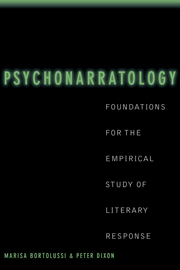Book contents
4 - Events and Plot
Published online by Cambridge University Press: 28 July 2009
Summary
Perhaps the most salient and obvious characteristic of a narrative is its plot, that is, the temporal, causal, or logical sequence of events that provide the basis of the story: Most, when asked to describe a narrative, will respond with a summary of the plot. Attempts at characterizing the nature of events and plot go back at least as far as Aristotle, and it has been a central problem in the scholarship on narratology since the pioneering work of Propp (1968; originally published in 1928) on story grammars. Yet more than seventy years after the original Russian publication, our conceptual understanding of narrative events and plot is far from complete. In this chapter, we summarize some of the issues in the debates concerning plot structure. Our analysis is that at the heart of many of the controversies lies the issue of how the reader's experience of plot should be handled and, in particular, the problem of distinguishing textual features from reader constructions.
There is a surprising similarity among the debates that have gone on in literary studies, discourse processing, and artificial intelligence concerning the appropriate starting point in the analysis of plot. In all these domains, an important question has been whether it is more appropriate to analyze plot structure based on the manner in which the story is told, that is, as a property of the discourse, or as reflecting properties of the story world itself.
- Type
- Chapter
- Information
- PsychonarratologyFoundations for the Empirical Study of Literary Response, pp. 97 - 132Publisher: Cambridge University PressPrint publication year: 2002



